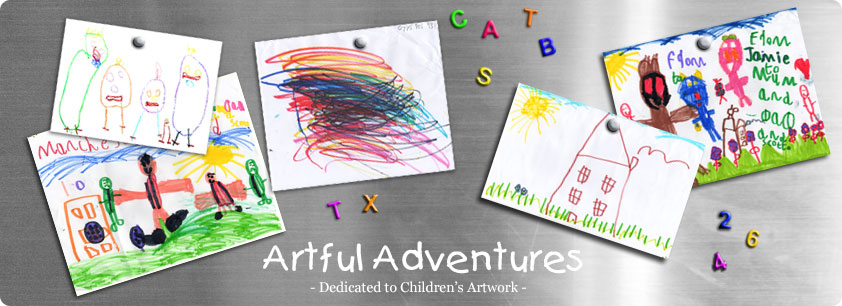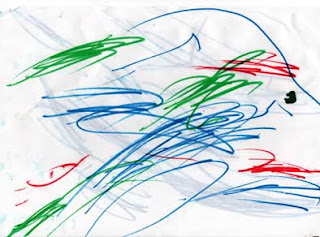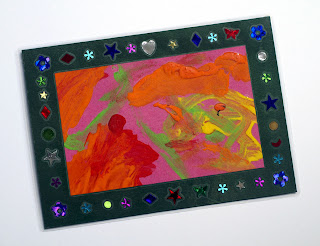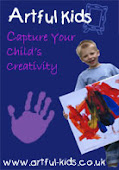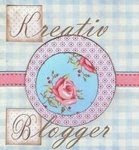This week I thought I’d take a look at how children’s artwork develops from their earliest scribbles and daubs, through to about the age of 11 or 12. Although all children will show the same broad developmental stages, the age at which they are reached may vary a little from child to child. In spite of this, within each stage every child will have their own particular style and characteristics which reflect their personality. The terminology used for the different stages, does appear to vary somewhat according to the author you read, but broadly the development is as follows:
Beginnings
The earliest stage, which begins at around 18 months or a little earlier, is that of simple scribbling. To begin with, the scribbles are entirely random since the child does not yet have the control necessary for anything else. The earliest scribbles are a series of left and right motions, then later, circular motions are added as more control develops. The markings can be strong or light according to the child’s personality. From about their second birthday, as the child gains more muscle control, a more controlled form of scribbling starts, and more demanding patterns of simple shapes, circles, wavy lines and crosses are produced. The child also becomes interested in arrangement and can produce simple collages of coloured paper, or place stones in patterns. Once children have established this ‘controlled scribbling‘, they begin to name their scribbles - an important milestone in their development. Though the appearance of this work may be simple, the first scribbles a child makes are precious. I still have the earliest drawings that my 2 boys ever made, and I don’t intend to throw them away - they are as important to me as the lock of hair from their first hair-cut (well actually 2nd or 3rd hair cut in the case of my eldest son, since I kept losing it!) or their first words.
The next stage of scribbling is when the child begins to name their scribble. I think this is just about the stage that my 2 (soon to be 3) year old has reached. He will do what appears to be a not entirely random scribble with red crayon, and tell me that it is a fire-engine, or choose a yellow crayon and tell me his drawing is a banana. I have to take his word for it, as they appear completely abstract to me. However, in his mind, that’s what it is.
Increasingly though now, I am beginning to see the occasional more recognisable shape appearing, which he takes great care with. It appears that the act of drawing is now less about the action, than the storytelling, or a more imaginative approach. He may have been influenced in this a little by his elder brother, but it appears that he is now approaching a crucial stage that children go through as their artistic prowess develops, the stage where true recognisable representations first occur. As a parent, I find this stage quite exciting, as it offers further insight into the mind of your child.
Representation
This next stage, which normally occurs from about the age of 3 is usually called ‘pre-symbolism’ or ‘pre-schematic’ and this represents the first conscious creation of form. The earliest recognisable drawings are usually simple figures, created by combining circles and lines. This reflects the child’s social progress. Other forms develop as time goes on, and the symbols constantly change as new concepts develop. The drawings usually indicate what the child thinks is most important about the subject, and objects are placed apparently randomly on the page. Realism is not the objective here - the child is representing a concept rather than observing. Emotions will influence their drawings more than reality, so that when a child draws mummy next to a house, she may be depicted larger than the house, because she plays a more important part in the child’s life. The use of colour is also more emotional than logical.
At around the age of 4 or 5 children will start to develop more complex stories around their drawings, changing basic forms as needed to express them. As their social world broadens and they start school, children enter the ‘schematic’ or ‘symbolic’ stage. Realism is still not the objective, instead the child creates a vocabulary of images or their own set of symbols which are based on their understanding of what is being drawn rather than on observation. Each child’s symbols are therefore unique to the child. You will still see exaggeration between figures used to express strong feelings about a subject.
It is at about this stage that a greater awareness of the concept of space develops. The beginnings of composition appear, items in the drawing will begin to be spatially related, and the familiar ‘baseline’ at the bottom of the paper is introduced to organise the space on the page. Often green (to represent grass) the figures will stand on this line. Slightly older children may add secondary baselines for background objects, and a blue skyline for the sun and clouds. This is the stage which my elder son, at just turned 5 has reached - he has been using a base line at the bottom of the page and a sky line at the top for several months now. Apparently at 3, just 1% of children will use a baseline (so if your 3 year old is using one, they are artistically advanced!), while at 8, a massive 96% will use one. At this point cultural influences become more important. For example they may start copying cartoons or things they see on TV. My son has been heavily into this for about a year now, especially Power Rangers and Transformers. Other typical features are that colours become more naturalistic, and objects in the drawing have a relationship to what is up and what is down.
Reality Bites
As the child matures and reaches around 9 years old, they begin to have an increased concern for realism, and find that their generalised symbols are too limiting and don’t look like the real thing. This is the first time that the child becomes aware of their lack of ability to depict things realistically, and it can be a frustrating time for some, as their aspiration outstrips their abilities and knowledge. Some children give up on drawing almost entirely at this point. However others become skilled, and it is at this stage that formal artistic training can benefit the child most. At first this new attention to realism often manifests itself by an increasing concern for detail, and there is a conflict between how the subject actually looks and what the child knows about the object. Formal training which will teach them how to see and observe- for example leaves are not just green, the sky is not just blue - and an introduction to the rules of perspective, can help to resolve the conflict. However, even without this, some children do start to show an appreciation of basic perspective - the baseline disappears, and they will begin to depict overlapping objects and a horizon, along with the use of small to large objects, to represent distance. Some use of shading is also seen.
At this ‘gang stage‘, a child can have a level of self-awareness to the point of being extremely self-critical, and their drawings are often less spontaneous as a result.
Bizarrely my elder son, being something of a perfectionist, sometimes seems to be exhibiting the kind of behaviour expected at around 9 years old, even though he is only 5, in that quite often if his drawing does not conform to what he is trying to do (or has seen me do) he will announce in frustration ’that’s rubbish‘, screw it up and go into a sulk. I am trying to combat this by showing him ways of ’salvaging’ mistakes, or even the idea of the ’happy accident’ where you capitalise on them, and by generally emphasising the importance of practice, learning and experience. I think I’m having some success, but sometimes it’s a hard slog!
And Finally….
The final, pre-adolescent stage occurs at around the age of 10-13. At this stage, as indeed we saw earlier, the importance the child attaches to realism, often discourages them. Unfortunately many people remain in this stage throughout adulthood because they do not continue trying.
Of course I have only touched the surface here of a much more in-depth field, so if anyone wants to explore it further, the following references and suggestions for further reading may help - I intend to explore them further myself at some point!
Herbert Read 'Education Through Art' 1966
Rhoda Kellog 'Analysing Children's Art' 1970Viktor Lowenfeld 'Creative & Mental Growth' 1978
David Lewid & James Greene 'Your Child's Drawings:Their Hidden Meaning' 1983
http://en.wikipedia.org/wiki/Child_art
Tuesday 27 October 2009
Tuesday 20 October 2009
Kids Mats-erpieces!
I came across a brilliant new product the other day, which really excited me with its possibilities, only to discover that it's not yet available in Europe, (as with lots of these things, it originates in the US). Basically it's whiteboard paint which enables you to paint a whole wall and use it as a canvas or noticeboard - something you can't really do with blackboard paint without making the whole room dark. It's available in two different kinds from ideapaint.com - professional (which takes a week to 'cure' once applied, and is solvent based, so is not really appropriate for a home environment) which is available here now, and the water-based CR8 paint, which isn't. I am so frustrated! Hopefully it will become available in the not too distant future, as there are quite a few places I can think of using it, aside from the obvious kids bedrooms.
Mats-erpieces
OK so I know the title is really corny, but this week I thought I'd introduce another really simple, but useful way of using kids artwork to create laminated place mats or work mats. I should perhaps point out here that these are more for creating a wipe clean surface to contain mess, rather than for protecting from heat!
The very simplest idea, if you have an A3 or A4 piece of artwork, is simply to laminate it as it is. But if the original artwork is a non-standard size, then mounting it onto a sheet of coloured paper or card, will give you the correct dimensions, and add further creative potential. Using a thin card base results in a stiffer mat. The background can act as a frame for the artwork, or you could also experiment with patterned backgrounds such as those created by bubble prints or marbling (if you have any of those) or even commercially available papers if you don't.
This is also quite a good way of using collage work, as long as it is flat enough to go through a laminator. Sequins, tissue paper, glitter, leaves etc. can all be used. For example you could easily create an autumn themed mat in this way
As well as artwork, you can also include handprints, or photos, or add your child's 'signature' - all of these things help to personalise the finished mat.
Instead of using a single artwork for a mat, you could create a composite image from different elements or motifs cut from several different artworks, as I did with this one. Alternatively you could crop a larger painting and create your own decorative frame, to create a mat full of 'bling' like this one.
And finally....
I saw this ad in the Financial Times this weekend - it was advertising their regular Mrs Moneypenny feature, ('10 years of our ultra straight-talking mother and businesswoman') but it just amused me, so I thought I'd share it. The quality of the image isn't great, but hopefully you can read it!
Mats-erpieces
OK so I know the title is really corny, but this week I thought I'd introduce another really simple, but useful way of using kids artwork to create laminated place mats or work mats. I should perhaps point out here that these are more for creating a wipe clean surface to contain mess, rather than for protecting from heat!
The very simplest idea, if you have an A3 or A4 piece of artwork, is simply to laminate it as it is. But if the original artwork is a non-standard size, then mounting it onto a sheet of coloured paper or card, will give you the correct dimensions, and add further creative potential. Using a thin card base results in a stiffer mat. The background can act as a frame for the artwork, or you could also experiment with patterned backgrounds such as those created by bubble prints or marbling (if you have any of those) or even commercially available papers if you don't.
This is also quite a good way of using collage work, as long as it is flat enough to go through a laminator. Sequins, tissue paper, glitter, leaves etc. can all be used. For example you could easily create an autumn themed mat in this way
As well as artwork, you can also include handprints, or photos, or add your child's 'signature' - all of these things help to personalise the finished mat.
Instead of using a single artwork for a mat, you could create a composite image from different elements or motifs cut from several different artworks, as I did with this one. Alternatively you could crop a larger painting and create your own decorative frame, to create a mat full of 'bling' like this one.
And finally....
I saw this ad in the Financial Times this weekend - it was advertising their regular Mrs Moneypenny feature, ('10 years of our ultra straight-talking mother and businesswoman') but it just amused me, so I thought I'd share it. The quality of the image isn't great, but hopefully you can read it!
Monday 12 October 2009
Storing kids artwork - just where do you keep it all?
I can't believe it's a week since my last post - the time just goes so quickly! This week I have decided to look at a few products available for displaying and storing kids artwork - it's something which I will introduce from time to time as I see them, but given the relative rarity of such products, it probably won't be too frequent. It's amazing how many products are out there for kids arts and crafts - thousands of brilliant ideas which you could spend a fortune on, but it seems there's not quite so much out there for displaying and storing the finished product.
A4 Picture Pockets

This giant PVC picture holder has 9 pockets for 18 A4 -sized artworks, and is a simple way to display kids artwork and keep it clean. It is available for £15.00 from Aspace
Children's Art Portfolios


Not something that you see very often, Letterbox have a number of kids portfolios available which offer a special and attractive way of storing their artwork.
The simplest traditional style folios, at just £6.99 are illustrated with a choice of 3 different themes, and tied with ribbons. They can store artwork up to A3 in size.

They also have a more expensive filing system version which can be personalised with a photograph. With a carry handle and 9 expandable pockets, it will accomodate artwork up to A3 in size, and is available for £16.99.

However, if A3 is too small, and your child is producing larger masterpieces, then you may need to consider these heavy-duty polypropylene art folders which will accommodate artwork up to A2 in size. Available in pink or blue for £13.00 from the Great Little Trading Company.

Alternatively of course, you could always create your own art storage system for A4 work, by decorating and personalising your own ring binder with loose leaf plastic pocket inserts. In fact I might just go and do that!!
And Finally....
A late addition, which I have just seen, and which seems appropriate for here, is another storage idea for kids artwork which Vertbaudet have to offer. This Drawing Tidy offers 4 stacked compartments for storing and sorting drawings. It is fixed to the wall, and is 35 cms wide. It is currently available for £39.00.

Needless to say, if anyone else out there has come across any other products, or brilliant ideas for storing and displaying kids artwork, please feel free to share them!
A4 Picture Pockets

This giant PVC picture holder has 9 pockets for 18 A4 -sized artworks, and is a simple way to display kids artwork and keep it clean. It is available for £15.00 from Aspace
Children's Art Portfolios


Not something that you see very often, Letterbox have a number of kids portfolios available which offer a special and attractive way of storing their artwork.
The simplest traditional style folios, at just £6.99 are illustrated with a choice of 3 different themes, and tied with ribbons. They can store artwork up to A3 in size.

They also have a more expensive filing system version which can be personalised with a photograph. With a carry handle and 9 expandable pockets, it will accomodate artwork up to A3 in size, and is available for £16.99.

However, if A3 is too small, and your child is producing larger masterpieces, then you may need to consider these heavy-duty polypropylene art folders which will accommodate artwork up to A2 in size. Available in pink or blue for £13.00 from the Great Little Trading Company.

Alternatively of course, you could always create your own art storage system for A4 work, by decorating and personalising your own ring binder with loose leaf plastic pocket inserts. In fact I might just go and do that!!
And Finally....
A late addition, which I have just seen, and which seems appropriate for here, is another storage idea for kids artwork which Vertbaudet have to offer. This Drawing Tidy offers 4 stacked compartments for storing and sorting drawings. It is fixed to the wall, and is 35 cms wide. It is currently available for £39.00.

Needless to say, if anyone else out there has come across any other products, or brilliant ideas for storing and displaying kids artwork, please feel free to share them!
Monday 5 October 2009
Valuing & Using Children's Artwork
Today I was having a conversation with an acquaintance about children's artwork and the service that Artful Kids provides. Many people comment that the finished result makes a good gift idea for grandparents, and she announced on hearing this that she didn't think her parents would appreciate it because they have 'proper art' on their walls. I was genuinely shocked at this attitude, which may or may not have reflected the attitude of her parents, and thought that it was actually quite sad and insulting to children. Why is children's artwork not considered to be 'proper art'? Surely it is the way it is presented or regarded that determines how 'proper' it is. A tatty bit of paper on the fridge is admittedly not going to look too impressive stuck on the living-room wall, but properly presented it can look as good (and sometimes a lot better) than any adult's work.
Children have a directness and honesty about their work that adults can only aspire to. Many famous artists have consciously striven to achieve the same, knowing that in reality they are doomed to fail because of the years of knowledge and experience that interfere with what we see. Children also have a lack of self-consciousness in their artwork that adults tend to lose - they simply don't have the same inhibitions - an enviable state to be in.
The conversation made me think that I may have an uphill struggle to convince people that a child's artwork is no less worthy of consideration than that of an adult, or of presenting well. In fact the whole idea of taking a child's artwork and presenting it in different ways, seems to be an alien concept - on a number of occasions I've been met with confused looks when I have attempted to explain what I do. Still there's nothing like a challenge, and I shall continue with my missionary zeal!
Anyway I think it's time to step off my soap box now, and move onto something more creative as I promised in my last post. I said last week that this time I’d look at how to use some of the mountains of artwork that you sometimes acquire (at least I do, since I can never bear to throw any of it away!) to make cards, gift tags, bookmarks or nursery art. The idea is really simple but surprisingly effective, and involves treating the painting as if it were a piece of decorative paper, and then using it to cut out simple shapes. These can either be drawn freehand, or alternatively some of the kids stencils that are available can be used if you're not confident of your drawing skills.

The following is a list of ways you can use the technique, or enhance it:

Over the coming weeks I will be adding lots more ideas for using and displaying kids artwork, but if you have any of your own, please feel free to share them, either here or on the Artful Kids Facebook page (see link adjacent). All ideas used will of course be acknowledged. Even better if you also have some photos of the finished product!

Children have a directness and honesty about their work that adults can only aspire to. Many famous artists have consciously striven to achieve the same, knowing that in reality they are doomed to fail because of the years of knowledge and experience that interfere with what we see. Children also have a lack of self-consciousness in their artwork that adults tend to lose - they simply don't have the same inhibitions - an enviable state to be in.
The conversation made me think that I may have an uphill struggle to convince people that a child's artwork is no less worthy of consideration than that of an adult, or of presenting well. In fact the whole idea of taking a child's artwork and presenting it in different ways, seems to be an alien concept - on a number of occasions I've been met with confused looks when I have attempted to explain what I do. Still there's nothing like a challenge, and I shall continue with my missionary zeal!
Anyway I think it's time to step off my soap box now, and move onto something more creative as I promised in my last post. I said last week that this time I’d look at how to use some of the mountains of artwork that you sometimes acquire (at least I do, since I can never bear to throw any of it away!) to make cards, gift tags, bookmarks or nursery art. The idea is really simple but surprisingly effective, and involves treating the painting as if it were a piece of decorative paper, and then using it to cut out simple shapes. These can either be drawn freehand, or alternatively some of the kids stencils that are available can be used if you're not confident of your drawing skills.

The following is a list of ways you can use the technique, or enhance it:
- Simple squares and rectangles mounted onto a plain card can look really effective - especially if the name of the child is handwritten beneath to give a personal touch.
- The different effects you can achieve are endless, since the item can be further decorated with accents such as sequins, jewels, or glitter glue.
- The shapes themselves can be mounted onto simple painted backgrounds, or just plain white or coloured card.
- For Christmas cards, the paintings can be cut into small squares and rectangles, which can be used to look like gift-wrapped parcels with the addition of glitter glue for ribbon ties for example - a really simple way of creating personalised Christmas cards. I made cards using this technique 2 years ago with my then 3 year old son. I had to give him quite a bit of help, but he was able to choose the pieces of paper and stick them on and the finished cards were really effective. Unfortunately I didn't take any photographs at the time!
- The technique can also be used to create effective framed nursery art.

Over the coming weeks I will be adding lots more ideas for using and displaying kids artwork, but if you have any of your own, please feel free to share them, either here or on the Artful Kids Facebook page (see link adjacent). All ideas used will of course be acknowledged. Even better if you also have some photos of the finished product!

Subscribe to:
Posts (Atom)
